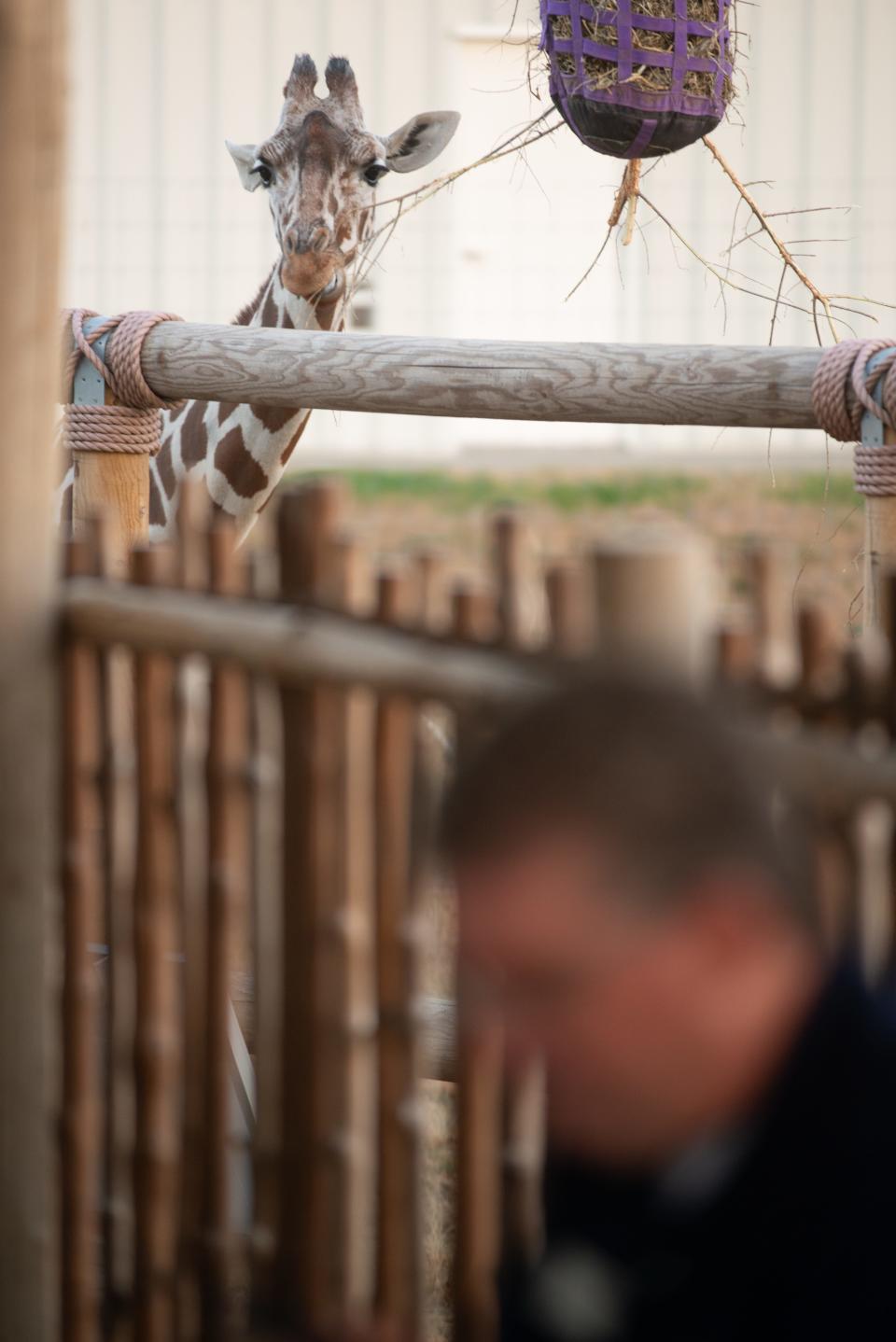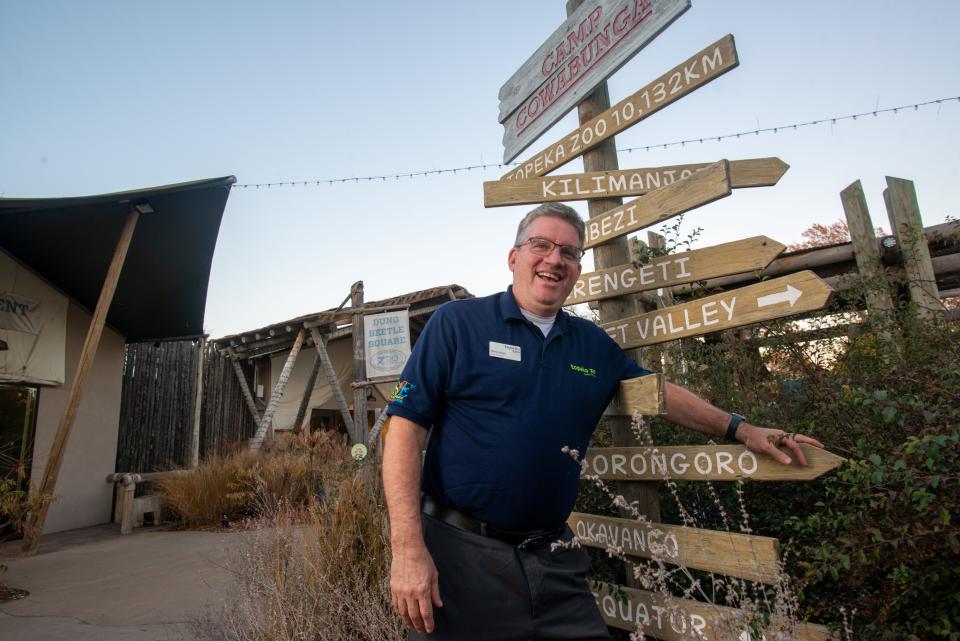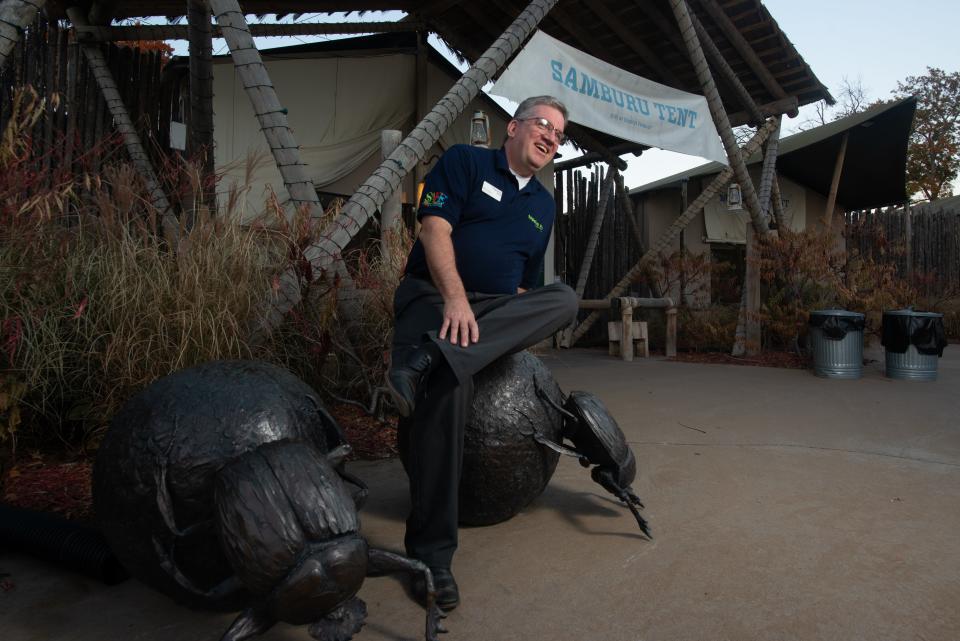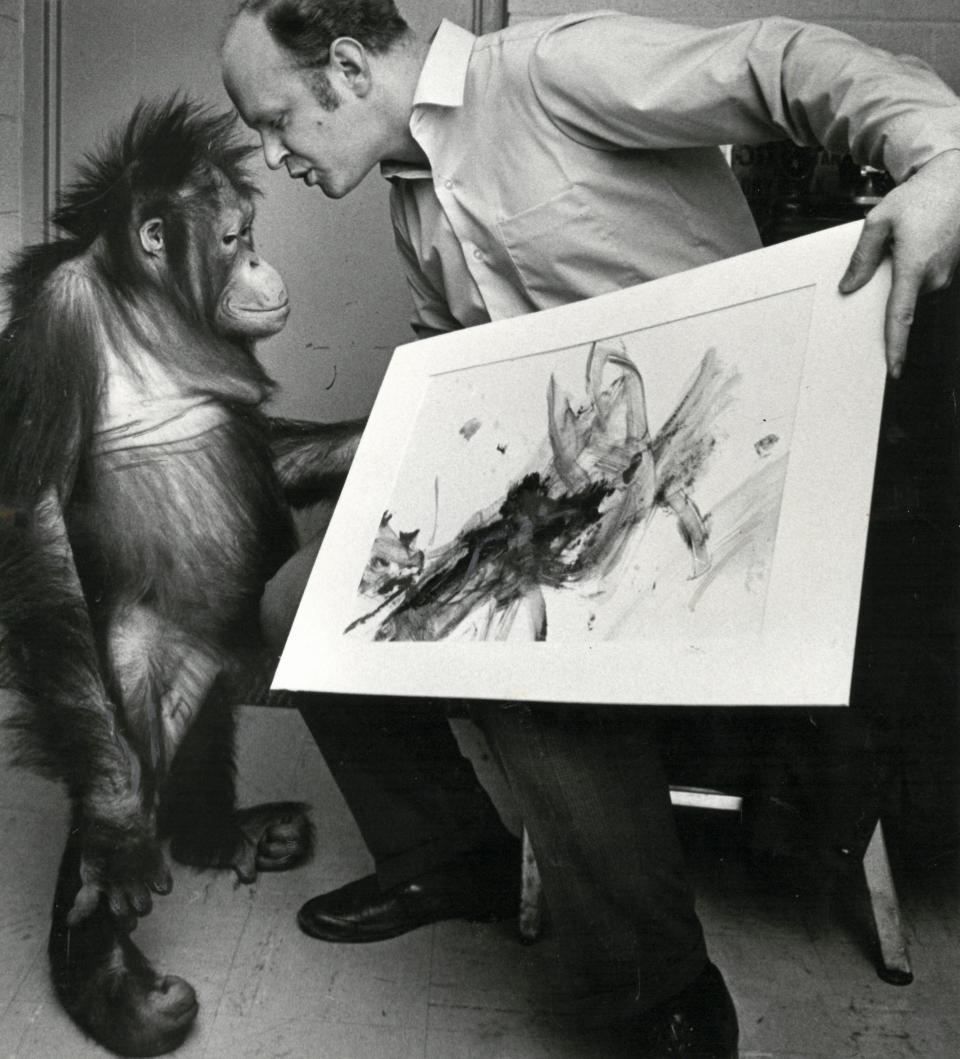Hope, Vision and a culture change: How Brendan Wiley helped save the Topeka Zoo
Brendan Wiley's eyes welled up with tears Tuesday as he recalled revealing in July 2010 that a baby giraffe with deformed hooves at the Topeka Zoo would be euthanized if her condition deteriorated.
"I remember writing a press release that night, kind of preparing the community that she probably wasn't going to live through the week," Wiley, the zoo's CEO, told The Capital-Journal.
But that giraffe, named Hope, still lives at that zoo after Topeka veterinarian Joseph Kamer developed ground-breaking medical procedures that enabled her to survive.
By keeping Hope alive, the zoo gave a much-needed boost to the spirits of its staff members and supporters at a really rough time, Wiley said.
"She saved the zoo," he said. "She just became this symbol for what we could become again."

World-Famous Topeka Zoo nickname started in early 1970s
Wiley, 53, resigns effective Friday to become director of the city-run Cameron Park Zoo in Waco, Texas.
He leaves the Topeka Zoo in much better shape than it was when he came here in May 2010, said Chris Palmer, a board member from 2007 to 2013 for Friends of the Topeka Zoo.
FOTZ has run the zoo since its operations were privatized and Wiley became CEO in 2021.
But in 2010, FOTZ was the fundraising arm of the zoo, which was operated by Topeka's city government.
The zoo was previously known as the "World-Famous Topeka Zoo" for accomplishments that included being the site of the first birth of a giraffe in Kansas in 1970, being the first zoo worldwide to successfully hatch golden eagle chicks in 1971 and for opening its Tropical Rain Forest in 1974.
Still, when director Mike Coker retired in December 2009, the zoo was dealing with turmoil over the death of a hippo, pregnant giraffes, mistrust in management and a failure to obey federal rules.

City was dealing with regulation compliance at Topeka Zoo
Coker considered compliance with regulations to be something of a burden and viewed inspectors in a manner that was somewhat adversarial, Palmer said.
He recalled Coker telling the FOTZ board that the zoo was "doing fine" and the U.S. Department of Agriculture and Association of Zoos and Aquariums each had a "different way of looking at things."
The USDA is the federal agency responsible for enforcing the Animal Welfare Act and licensing animal exhibitors, while the AZA provides prestige by accrediting zoos that meet standards higher than those imposed by the USDA.
Those agencies found problems at the Topeka Zoo that included misleading statements from the senior staff and a lack of trust in management.
Coker told The Capital-Journal the zoo had made no repairs before, during or after the 2006 death from a seizure of SubMarie, an aging hippopotamus who was found in 108-degree water.
But the city later released documents showing maintenance had been ongoing on the hippo pool before SubMarie's death and that repairs began the day after her death.
The AZA in March 2010 tabled a decision for one year on whether to continue or rescind its accreditation of the Topeka Zoo.
Wiley, a former curator at the Kansas City Zoo and director of an animal shelter in Johnson County, started work two months later as the Topeka Zoo's director. The AZA restored the zoo's accreditation to full status in March 2011.
'Brendan was the closer'
While there were other quality applicants for zoo director, Wiley was clearly the best, said Palmer, who was then FOTZ's vice president and represented it on the committee that interviewed applicants.
"He just had this air about him," Palmer said. "You felt better around him."
After he was hired, Wiley proved to be particularly good at helping FOTZ raise money, Palmer said.
"If we got in front of a supporter that was interested in potentially donating, Brendan was the closer," he said.
One of Brendan Wiley's first tasks was addressing culture change
At a meeting on his first day at the zoo, Wiley learned some zoo staff members were too embarrassed to wear clothing bearing the zoo staff logo to the grocery store after work.
The zoo still had "good bones" and the community still had an affinity for it, but the zoo also had some significant problems, Wiley said.
One, he said, was that the zoo "could not catch a break" during inspections by the AZA and USDA.
Wiley said he and his staff consequently committed to implementing a "culture change" through which they made a commitment to taking the Animal Welfare Act very seriously.
The zoo began a process, which remains in effect today, of self-reporting to the USDA situations in which it may have jeopardized any standard of that act.
The zoo also made it clear to inspectors that it saw them as partners and not adversaries, Wiley said.
Over time, he said, the zoo's relationships with the AZA and USDA improved considerably.
The zoo hasn't received a USDA noncompliance citation in at least six years, he said.
Two giraffes, a zebra and a hippo challenged Topeka Zoo
Wiley said his first year at the zoo found him dealing with situations that included the following:
• Two pregnant giraffes who, in theory, shouldn't have been allowed to become pregnant because of their advancing age.
• A zebra staff members thought was pregnant but wasn't.
• A hippo who was pregnant, but zoo staff members didn't realize it.
The giraffes, B.G. and Dolly, were both 25 years old. B.G. and her unborn calf died in August 2010.
Dolly, whose last previous calf had to be euthanized in 2006 while suffering from a congenital hoof problem, gave birth in July 2010 to Hope, who had the same type of problem as Dolly's previous calf.
But Kamer managed to save her, bringing the zoo national attention.
Hope ran for the first time when she was a month old, moments before she was to appear on "The Today Show."
Mara, the hippo who turned out to be pregnant after zoo staff members thought she wasn't, then gave birth in August 2010 to a son, who remains at the zoo today.
Topeka's Vision Bank, which is now Community National Bank, bid $4,200 at an auction for the right to name the newborn. He was given the name Vision.
By that time, the zoo seemed to be getting back its positive reputation, Wiley said.
"All of a sudden, things started getting better," he said.
Camp Cowabunga takes guests on an African safari

When Wiley applied for the Topeka Zoo's director's job in 2010, a mentor of his suggested he call Gary Clarke.
Clarke was the Topeka Zoo's director from 1963 to 1989, then left to organize and guide African photo safaris for Cowabunga Safaris, his Topeka-based business.
He went on his last safari in 2006, after which he maintained an office in Topeka and wrote books about Africa and his experiences.
Wiley said he telephoned Clarke in 2010, said he was interviewing to become director of the Topeka Zoo and asked to hear the story about how that facility became the "World-Famous Topeka Zoo."
"Gary said, 'If you want to know the story, get the book,' and then hung up," Wiley recalled.
Later, Wiley said, after he had been hired as zoo director but hadn't started work, he went to Clarke's Cowabunga Safaris office in Topeka, opened the door and said, "I'm here to get a copy of the book."
What happened next was "instant friendship," Wiley said.
Wiley didn't initially ask Clarke to get involved again with the Topeka Zoo because Wiley thought he first needed to spend "a couple years righting the ship," he said.
But Wiley invited Clarke in March 2014 to take part in a meeting focusing on the zoo’s plans to develop a major African animal exhibit.

Clarke played a key role in creating Camp Cowabunga, a complex the zoo opened in 2018 that's designed to make visitors feel like they are on safari.
Wiley recalled proudly how he was walking through that camp one day when he heard a child tell his mother, "I can't believe this is in our city."
Clarke died at age 79 in January 2019.
Penguins, alligators and sea lions have visited Topeka
While Clarke never told Wiley how to do his job, he made occasional suggestions, including noting that traveling exhibits had formerly been pretty successful at the Topeka Zoo.

Wiley said he responded by arranging for the zoo to host traveling exhibits featuring penguins in 2012, alligators in 2013 and sea lions in 2018.
While zoo visitors seemed "a little disappointed" by the penguins, the alligators "completely exceeded their expectations" and the sea lions were "not only fun but brought in lots and lots of people," Wiley said.
The zoo teamed up with other local attractions in 2022 by offering "Dinosaurs Alive!" which featured 20 life-sized, robotic dinosaurs that roared and moved, as part of "Topeka Dino Days," which was arranged by Visit Topeka Inc.
Awkward meeting with Kay McFarland led to her Japanese Garden
Retired Kansas Supreme Court Chief Justice Kay McFarland had gone on three African photo safaris with Clarke.
Wiley asked if she would be willing to help financially support creating Camp Cowabunga.
"She emphatically said, 'No,'" Wiley said. "Her quotes included the fact that she didn't like zoos and she didn't really like elephants. We had the meeting in a private place in the back of the zoo, and it was the most awkward golf cart ride back to the front that I had ever experienced."
But McFarland kept some written materials Wiley had provided her.

She called him back about two weeks later to ask about some property that had been set aside for an Asian Garden in the zoo's master plan.
McFarland then revealed she had an affinity for koi ponds.
In the 18 months before she died at age 80 in 2015, McFarland worked with zoo officials on plans for what became the Kay McFarland Japanese Garden. She established a living trust to pay more than 62% of the project costs.
McFarland is "the matriarch who dreamed bigger than we did," Wiley said.
The garden, which opened in 2020, brings in many people who wouldn't otherwise come to the zoo, including couples who get married there, Wiley said.
Jacob Wiley, the oldest of Brendan Wiley's two children, married his wife, Olivia, there on Sept. 23.
Zoo Lights brought in $1 million revenue in 2022
Topeka Zoo officials started talking in 2013 about offering a Zoo Lights attraction, but it wasn't until about 2018 that a zoo contributor agreed to donate money to support it, Wiley said. That donor's identity remains confidential.
Evergy then decided to also donate to help finance Zoo Lights, an attraction that features a winter wonderland of Christmas lights displayed in various colors and shapes.
After spending a couple years in the making, Zoo Lights was coincidentally first held near the end of the pandemic year of 2020, Wiley said.
"It was the perfect pandemic event," he said.
Zoo Lights has since brightened the zoo's December attendance considerably.
It generated more than $1 million in revenue last year, Wiley said.
The zoo earlier this year then opened its Giraffe & Friends exhibit.
Topeka Zoo is looking to hire its 'next great director'
Palmer, who was FOTZ's vice president when Wiley became zoo director and then spent two years as its president, marveled at how much Wiley has done as zoo director.
Wiley has a way of "getting the best out of everybody," he said.
Palmer said he felt particularly pleased that Fawn Moser, current manager of zoo operations, will be the zoo's interim director while the search is conducted for Wiley's permanent replacement.
Wiley and Moser made a good team, Palmer said.
Wiley was the "big picture inspirational leader" while Moser was "the one who made sure everything got done and all the I's were dotted and the T's crossed," he said.
Wiley's success here has made the Topeka Zoo director's job a much more attractive one now than it was when he was hired, Palmer added.
He said, "Brendan put the zoo in a wonderful position to hire its next great director."
Contact Tim Hrenchir at threnchir@gannett.com or 785-213-5934.
This article originally appeared on Topeka Capital-Journal: How Brendan Wiley's 'big-picture' leadership turned Topeka Zoo around

